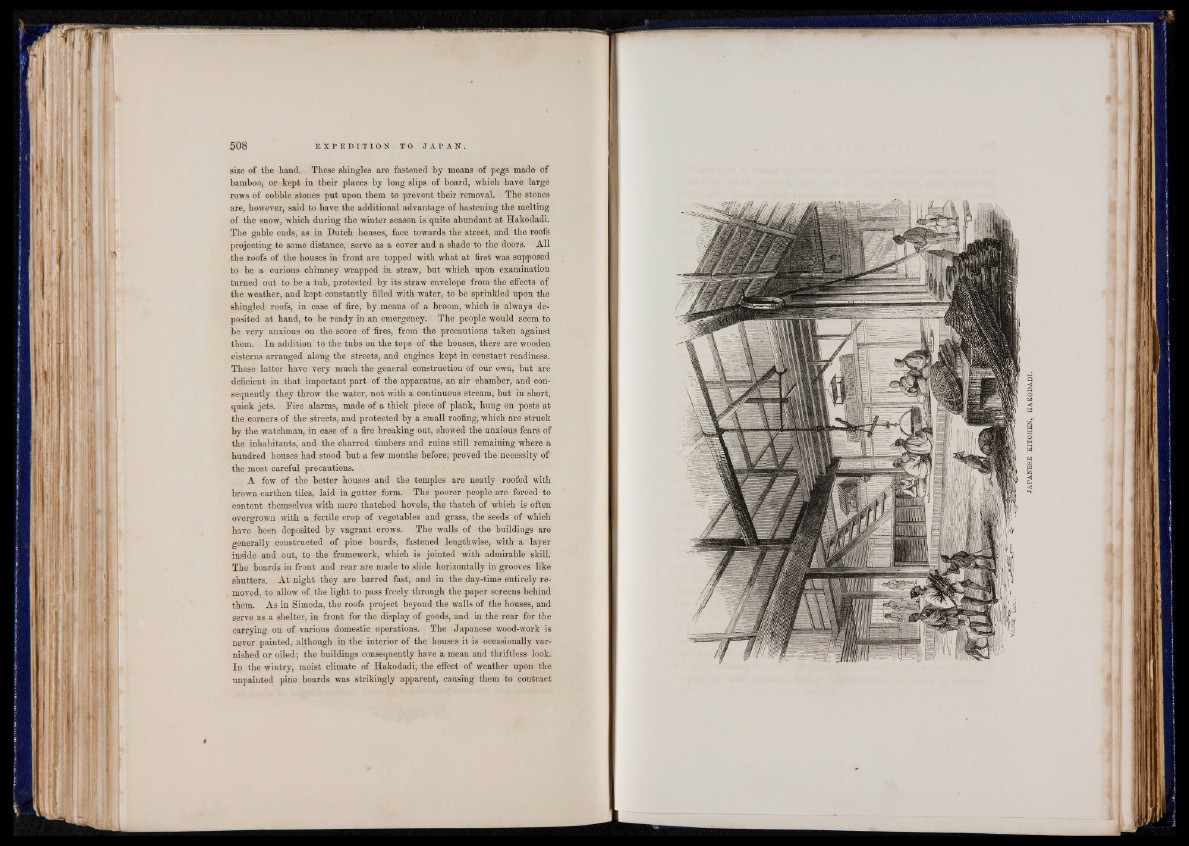
size of the hand. These shingles are fastened by means of pegs made of
bamboo, or kept in their places by long slips of board, which have large
rows of cobble stones put upon them to prevent their removal. The stones
are, however, said to have the additional advantage of hastening the melting
of the snow, which during the winter season is quite abundant at Hakodadi.
The gable ends, as in Dutch houses, face towards the street, and the roofs
projecting to some distance, serve as a cover and a shade to the doors. All
the roofs of the houses in front are topped with what at first was supposed
to be a curious chimney wrapped in straw, but which upon examination
turned out to be a tub, protected by its straw envelope from the effects of
the weather, and kept constantly filled with water, to be sprinkled upon the
shingled roofs, in case of fire, by means of a broom, which is always deposited
at hand, to be ready in an emergency. The people would seem to
be very anxious on the score of fires, from the precautions taken against
them. In addition to the tubs on the tops of the houses, there are wooden
cisterns arranged along the streets, and engines kept in constant readiness.
These latter have very much the general construction of our own, but are
deficient in that important part of the apparatus, an air chamber, and consequently
they throw the water, not with a continuous stream, but in short,
quick jets. Fire alarms, made of a thick piece of plank, hung on posts at
the corners of the streets, and protected by a small roofing, which are struck
by the watchman, in case of a fire breaking out, showed the anxious fears of
the inhabitants, and the charred timbers and ruins still remaining where a
hundred houses had stood but a few months before, proved the necessity of
the most careful precautions.
A few of the better houses and the temples are neatly roofed with
brown earthen tiles, laid in gutter form. The poorer people are forced to
content themselves with mere thatched hovels, the thatch of which is often
overgrown with a fertile crop of vegetables and grass, the seeds of which
have been deposited by vagrant crows. The walls of the buildings are
generally constructed of pine boards, fastened lengthwise, with a layer
inside and out, to the framework, which is jointed with admirable skill.
The boards in front and rear are made to slide horizontally in grooves like
shutters. At night they are barred fast, and in the day-time entirely removed,
to allow of the light to pass freely through the paper screens behind
them. As in Simoda, the roofs project beyond the walls of the houses, and
serve as a shelter, in front for the display of goods, and in the rear for the
carrying on of various domestic operations. The Japanese wood-work is
never painted, although in the interior of the houses it is occasionally varnished
or oiled; the buildings consequently have a mean and thriftless look.
In the wintry, moist climate of Hakodadi, the effect of weather upon the
unpainted pine boards was strikingly apparent, causing them to contract
♦